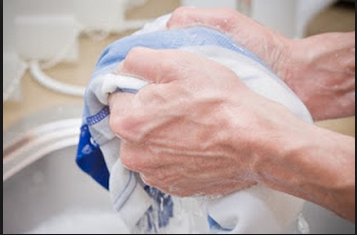How to Keep Whites White

Separate your white clothes and fabrics from your dark clothes before doing the laundry. Washing white and dark clothes, towels, sheets, etc., together can result in color transfer. Even if the color doesn't change, white items can appear dingier after coming into contact with darker colors. White clothes or fabrics also tend to pick up dark fluff and look unclean.
Separate by fabric type. Fabric types need to be taken into consideration when creating separate washing piles. Even whites need to be further separated as follows:
If, after a wash, the stain remains, go through the pre-treatment process againbefore drying your clothes. Drying clothes with stains on them can make stains next-to-impossible to remove.
Wash white clothes in hot water. Provided the fabric can handle hot water, this is the best setting for white clothes.
Use enough soap or detergent to wash dirt away.
Add a whitener or brightener to brighten the whites. You can use proprietary whiteners, or use your own from these suggestions: lemon juice; white, distilled vinegar; or, 3-percent hydrogen peroxide.
Use a color remover on your white clothes if they discolor, become dull or look dingy.
Wash and rinse the fabric or garment as usual.Rinse the fabric in a little vinegar and water.Hang in the bright sunlight to dry.
Adding water softener to your laundry cycle might improve the appearance of white clothes. Using hard water to wash white clothes can result in mineral transfer and deposits getting onto your clothes. A 1/2 cup of white, distilled vinegar can act as a natural water softener.For best results, pre-treat a stain as soon as it presents.
Hold the stain under running water. This water must be lukewarm, namely not too hot and not too cold. Keep the stain there until the water runs clear and no more of the stain appears to be coming out.
Create a mixture of glycerine and warm water. Make up this mixture of half glycerine and half warm water. Rub this mixture into the stain. Leave for 10 - 30 minutes. Rinse out.
Soak in biological detergent. This is a detergent used for washing clothing that contains enzymes.Wash as normal.Hang out to dry. Dry in your usual fashion.
Really stubborn curry stains can be treated using one part of hydrogen peroxide to six parts water. Only do this if the fabric is suitable however; this is serious bleach and will also weaken fabric threads.
The main part of the stain is probably caused by the turmeric. Turmeric is actually also used as a dye, but it isn't 'fast' in sunlight.
Therefore, spot treat the stain,wash the garment, hang it out, and - eventually - it should fade. This will almost certainly need to be done more than once, though.
The main spice which is staining your clothes is mainly turmeric. Some of the curry powder stain could also be coming from cayenne pepper powder. You could applying Shout It Out by pre-treating it for 30 minutes. That sometimes works. You could also try washing it in Oxy-Clean (must be very fresh and brand new for maximum potency).
Get as much of the curry out as you can with water, while fresh, then let dishwashing liquid sit on the remaining stain for 15-30 minutes.if there is anything left, use white vinegar on it,repeat the dishwashing liquid and vinegar if necessary, until stain is completely gone, launder as usual.
Separate your white clothes and fabrics from your dark clothes before doing the laundry. Washing white and dark clothes, towels, sheets, etc., together can result in color transfer. Even if the color doesn't change, white items can appear dingier after coming into contact with darker colors. White clothes or fabrics also tend to pick up dark fluff and look unclean.
Separate by fabric type. Fabric types need to be taken into consideration when creating separate washing piles. Even whites need to be further separated as follows:
- Acetates and acrylics wash together
- Linen and cotton wash together
- Wool washes alone
- Delicates should be washed by hand.
- You can even use a bit of your normal liquid laundry detergent. Scrub the stain away using a new toothbrush.
- Always read the garment label before adding any stain remover.
If, after a wash, the stain remains, go through the pre-treatment process againbefore drying your clothes. Drying clothes with stains on them can make stains next-to-impossible to remove.
Wash white clothes in hot water. Provided the fabric can handle hot water, this is the best setting for white clothes.
Use enough soap or detergent to wash dirt away.
Add a whitener or brightener to brighten the whites. You can use proprietary whiteners, or use your own from these suggestions: lemon juice; white, distilled vinegar; or, 3-percent hydrogen peroxide.
- Pouring 1/2 cup of lemon juice or 1 cup of white, distilled vinegar or 3-percent hydrogen peroxide into your washing machine with your clothes can keep your white clothes white.
- If you use lemon juice, dry your clothes under sunlight, as ultraviolet rays can also help brighten whites.
Use a color remover on your white clothes if they discolor, become dull or look dingy.
- Color removers can remove the unwanted colors from whites. If you don't want to purchase a color remover, mix boiling water with oxygen bleach and let the clothes soak in the mixture for the same effect.
- If colors bleed during the wash, do not allow the garments or items to dry. Add color removers to the wash and do the whole wash again. Once the wash has dried, the color transfer tends to set.
- Select an appropriate load size. The clothes or other items should be able to move freely around in the water.
- Clean your washing machine regularly to ensure that your white clothes are actually being cleaned and that any remaining dirt in the washing machine isn't being transferred onto them.
- Be aware that bleach has been linked to numerous health problems.
Dealing with Yellowed White Fabric
How to Remove Curry Stains
Create a mixture of glycerine and warm water. Make up this mixture of half glycerine and half warm water. Rub this mixture into the stain. Leave for 10 - 30 minutes. Rinse out.
Soak in biological detergent. This is a detergent used for washing clothing that contains enzymes.Wash as normal.Hang out to dry. Dry in your usual fashion.
Really stubborn curry stains can be treated using one part of hydrogen peroxide to six parts water. Only do this if the fabric is suitable however; this is serious bleach and will also weaken fabric threads.
Therefore, spot treat the stain,wash the garment, hang it out, and - eventually - it should fade. This will almost certainly need to be done more than once, though.
Mix one tablespoon of liquid hand dishwashing detergent and one tablespoon of white vinegar with two cups of warm water.
Using a clean white cloth, sponge the stain with the detergent/vinegar solution. Blot frequently with a dry cloth until the stain disappears.
Sponge with plain water; blot until the liquid is absorbed.
Sponge the stain with rubbing alcohol; blot to remove the stain.
Sponge with water; blot until the liquid is absorbed.
If the stain remains, mix one teaspoon of liquid hand dishwashing detergent and one tablespoon of ammonia with two cups of warm water.
Sponge the stain with the detergent/ammonia solution. Leave it on the stain for at least 30 minutes, blotting every five minutes with a clean white cloth and more solution.
Sponge with cold water and blot dry.
Using a clean white cloth, sponge the stain with the detergent/vinegar solution. Blot frequently with a dry cloth until the stain disappears.
Sponge with plain water; blot until the liquid is absorbed.
Sponge the stain with rubbing alcohol; blot to remove the stain.
Sponge with water; blot until the liquid is absorbed.
If the stain remains, mix one teaspoon of liquid hand dishwashing detergent and one tablespoon of ammonia with two cups of warm water.
Sponge the stain with the detergent/ammonia solution. Leave it on the stain for at least 30 minutes, blotting every five minutes with a clean white cloth and more solution.
Sponge with cold water and blot dry.
Thanks for Visiting womenspage.in

 Posted in: home need tips,
Posted in: home need tips,
 Follow Us on Twitter!
Follow Us on Twitter!









